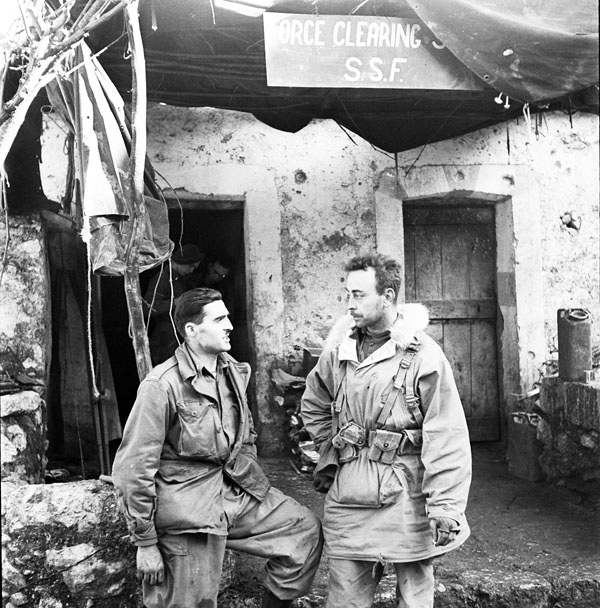Geoffrey N. Pyke, an Englishman, submitted Project PLOUGH to the British government in 1942 as an innovative operational concept. It caught the notice of Vice Admiral Lord Louis Mountbatten, Chief of Combined Operations. Pyke was offered a position on Mountbatten’s staff. Pyke’s 54-page report proposed commando force operations in Norway and Romania over the winter. Winston S. Churchill, the British Prime Minister, was enthralled by the concept. During a planning conference in London, he pitched the proposal to President Franklin D. Roosevelt and General George C. Marshall. Pyke hypothesized that a ten-thousand-man “North American Force” might encircle significant numbers of German troops in the seized countries by employing compact tracked vehicles to move quickly through the snow.

Because it was a one-way trip, Project PLOUGH was infeasible. It did spark the formation of the First Special Service Force (FSSF). A unique combined US-Canadian outfit. Based on the Project PLOW idea, a combined US-Canadian FSSF was activated at Fort William Henry Harrison, Montana, on July 9, 1942. Its structure was outlined in a binational legal agreement. Soldiers, equipment, and supplies were given by the United States Army, while the 2nd Canadian Parachute Battalion provided soldiers from Canada. From regiments to platoons, command positions were evenly distributed by country. Soldiers from the United States and Canada made up the units. Lieutenant Colonel Robert T. Frederick, a 1928 United States Military Academy alumnus, led the FSSF. Lieutenant Colonel John G. McQueen, a Canadian, served as Frederick’s executive officer. In the summer of 1942, a diverse group of volunteers came to Montana. It began a rigorous program of physical fitness, close combat fighting, airborne, demolition, mountaineering, amphibious, and winter warfare training. The FSSF was divided into three 600-man regiments, a service battalion, and a headquarters, with one-third of the Force being Canadian. LTC Frederick persuaded the War Department to employ the FSSF in recovering the Aleutian Islands after Project PLOUGH was canceled.

The Force led the attack on Kiska Island on August 15, 1943. Even though the Japanese had left, Kiska served as a crucial training ground for future operations. The combat-proven FSSF was deployed to Europe, notably to the Fifth U.S. Army in Italy (Lieutenant General Mark W. Clark). To break the German Winter Line, the Force took the 3,000-foot-high Monte La Difensa and La Rementanea mountain peaks, guarded by a Panzer Grenadier division, on December 2-3, 1943. Their relentless night patrols earned them the nickname “Devil’s Brigade” after they landed at Anzio on February 1, 1944. The FSSF led the Allied invasion into Rome on June 4, 1944, seizing vital bridges in preparation for the massive U.S. II Corps assault. In Rome, Colonel Frederick was wounded three times. Brigadier General Frederick, who had recently been elevated to Brigadier General, was assigned to head the 1st Allied Airborne Task Force during the invasion of Southern France. Colonel Edwin A. Walker of the United States Army acquired command of the 3rd FSSF Regiment. On August 14, 1944, he spearheaded the Force’s amphibious assaults on the Mediterranean islands of Port Cros and Levant. Operation DRAGOON allowed the Seventh United States Army (Lieutenant General Alexander M. Patch) to land safely in southern France. Five months later, on December 5, 1944, outside the village of Menton, France, the FSSF paraded one more time to commemorate the departure of the Canadians. After the FSSF was disbanded on January 6, 1945, American veterans formed the 474th Infantry Regiment (Separate). When the war in Europe ended in May 1945, the 474th was dispatched to Norway to disarm German soldiers.

The 1st Special Forces Regiment can trace its official U.S. Army history and accolades to the FSSF’s activation on July 9, 1942. The Force is represented by the S.F. Coat of Arms, embroidered on the S.F. Regimental colors. The shield was designed with the FSSF in mind. LTC Frederick created the V-42 fighting knife, which is included in the set.

The U.S. Army Indian Scouts first used the crossed arrows on the crest in 1890. During World War II, the Force wore them as a branch emblem. In 1960, the fighting knife and crossed arrows were added to the Regiment’s S.F. Distinctive Unit Insignia (DUI). The S.F. Shoulder Sleeve Insignia (SSI), often known as a “unit patch,” was adopted in 1955 and is shaped like the FSSF red arrowhead patch but with the words “USA” and “CANADA” embroidered in white. The Special Forces Regiment’s relationship with the First Special Service Force is still felt.

